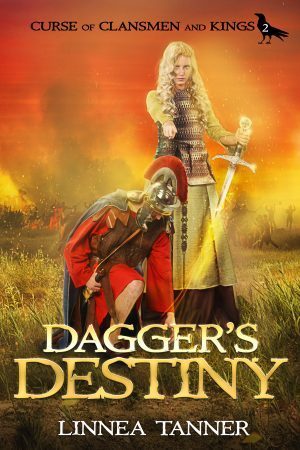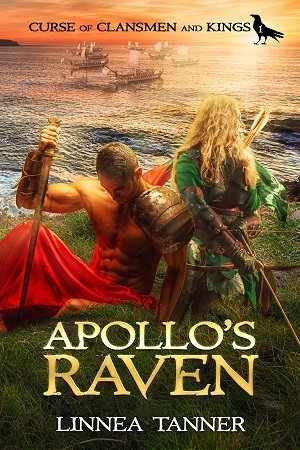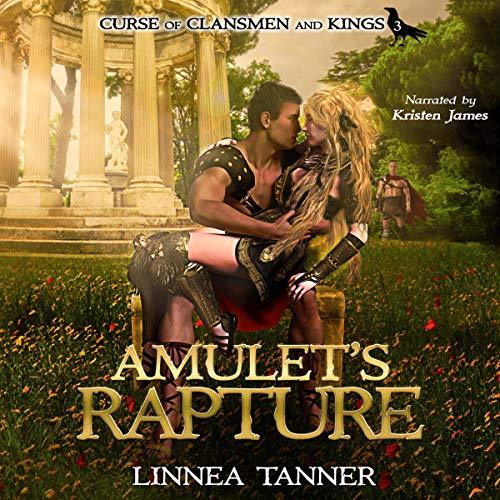Linnea Tanner's Blog, page 40
October 17, 2020
GOLDEN AGE OF CELTS: STATUS BUILT BY BATTLE OR FEAST
The whole race [Celts] is made for war. High-spirited and quick to battle.
— Strabo, Greek Historian
Introduction
The following is a reblog of a post entitled, “Golden Age of Celts: Status Built by Battle or Feast,” that was originally posted on February 25, 2014 as the beginning of a series that discusses the history of the ancient Celts that stretched the regions of Ireland, Northern Europe, and Turkey from 500 BC to 500 AD.
GOLDEN AGE OF CELTS
Status-Building in Battle
During the Golden Age of the Celts (Le Tène Period), cattle thievery, slave raiding, and vendettas between clans and tribes formed the basis of low-intensity warfare that permeated the Celtic society. Such conflicts were a starting point for a young warrior to demonstrate his bravery and skills at weapon-handling. In a society that took personal courage for granted, something more was required to establish a reputation.
One way was to serve as a mercenary in many of the various armies during the classical period. Renowned Celtic mercenaries served Hannibal during his invasion of Italy in the Second Punic War. The Celtic invasion helped establish Rome’s image of Celts as fierce warriors. They also fought in Greek armies and successor kingdoms following the break-up of Alexander’s empire in Egypt.

Statue of Dying Celtic Warrior
A distinct group of Celtic mercenaries called the Gaesatae joined the Cisalpine Gauls in the battle of Telemon against the Romans. These mercenaries were outside the normal social structure of the clan and tribes. The Celtic word geissi—bonds, taboos, or sacred rule of conduct—suggests these warriors had a strong spiritual aspect to their life, which will be further examined in later posts. It was the custom of Gaesatae to fight naked in battle as a ritual act.

Location of Battle of Telemon
Clearly, many Celts looked for fame and future in the lucrative Mediterranean world with the hope of returning home with their reputations established. Mercenary service also removed young warriors from the tribe when their drive to achieve high status was at their most intense. Control of imported goods, especially gold coins and Italian wine, also guaranteed a large following.
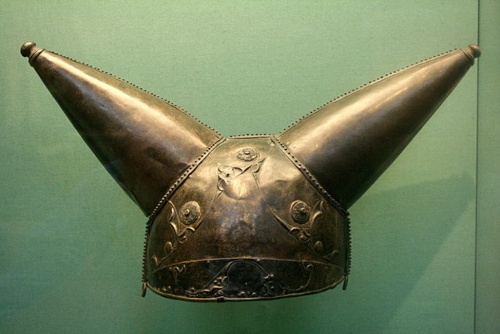
Celtic Horned Helmet Found at River Thames Date 150-50BC
Potlach
Previous posts highlighted that trade with the Mediterranean had a significant impact on Celtic society. Nobles rewarded warriors and other clients with foreign luxuries, the value of which was measured by the influence it could command by giving it away. This method of redistributing prestigious items to increase status is called potlatch.
The 1st Century BC Greek historian, Poseidonius, writes that Lovernius, a Celtic noble who attempted to win popular support by driving his chariot across his territory and distributing gold and silver to those who followed him. Moreover, a noble set-up separate enclosures one and one-half miles on each side. He filled vats with expensive liquor and prepared food for all who wished to feast—an important social gathering that was not unlike today’s celebrations. The feasts were usually wild and drunken, but strict ritual rules were obeyed.

Celtic Roundhouse for Assembly
Wild Celtic Feasts
Strict ceremonial rules were observed for seating participants according to rank and prowess. Poseidonius describes the arrangement as follows:
“…they sit in a circle with the most influential man in the center, whether he is the greatest in warlike skill, was the nobility of family or wealth. Beside him sat the host, and on either side of them were others in order of distinction. Their shield bearers stood behind them while the spearmen were seated on the opposite end. All feasted in common with their lords.”
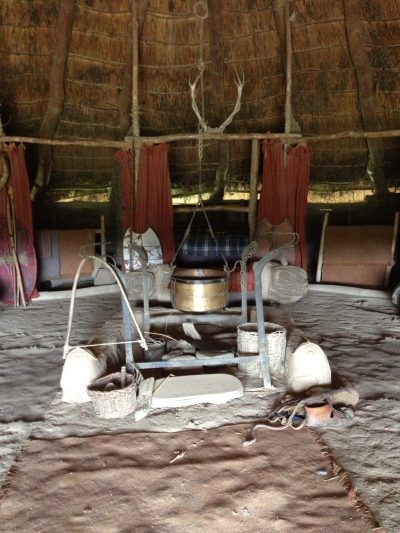
Central Hearth in Celtic Roundhouse
Also in attendance were bards who sang praises of their patrons’ lineage, bravery, and wealth. Their songs could praise and satirize their patron, thus encouraging nobles and warriors to be even more generous during the feast. Strangers could also share the meal before they were asked their name and business.
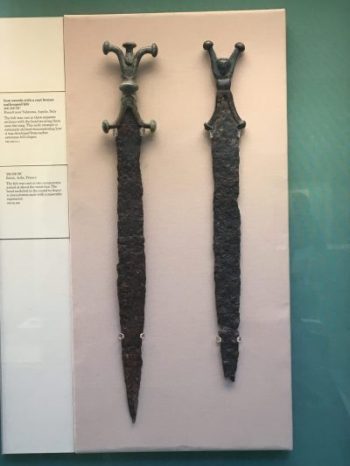
Celtic Swords Displayed at British Museum
Everyone had a piece of meat according to their status. Traditionally, the greatest warrior had the choicest cut, consisting of the thigh. When the hindquarters were served, another warrior could claim it and fight in single combat to the death against the champion to elevate his status. Others sought to reinforce their status through mock battle engagement that might escalate into more serious violence, possibly death. Poseidonius writes:
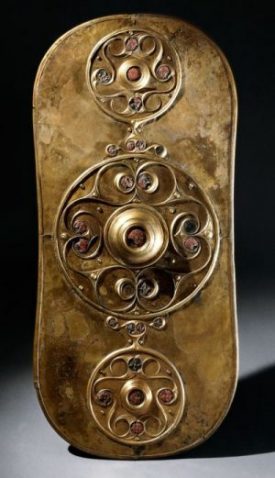
Celtic Shield Retrieved from Thames River
Conclusions
According to Caesar, the bravery of the Celts sprang from their lack of fear of death. This was because Celtic believed the soul does not die. The classical authors, Caesar, Lucan, and Diodorus Siculus, in particular, emphasized the Celtic belief in metempsychosis. At death, the soul passes from one body to another in reincarnation. This belief may, in part, explains why Celts felt it was important to establish their status in preparation for the journey to the Otherworld.
Not only did Celtic men fight bravely in battle, but historical accounts and mythology provide evidence that women held equal standing to men and often fought in battles and served as military and spiritual leaders. This will be discussed in the next post.
References:
John Davies, The Celts: Prehistory to Present Day; 2005. United States: Sterling Publishing Co., New York.
Stephen Allen, Celtic Warrior: 300 BC-AD 100; 2001. Osprey Publishing LTD., Westminster, MD, USA.
Julius Caesar, translated by F. P. Long, 2005. The Conquest of Gaul; United States: Barnes & Noble, Inc.
©Copyright February 25, 2014, by Linnea Tanner. ALL RIGHTS RESERVED.
September 22, 2020
SFF Book Bonanza and Latest Updates
For those who love to read science fiction and fantasy, check out the SFF Bonanza 99c Promo this week (21-27 September) in which you have close to 30 books to select from. As part of this promotion, Apollo’s Raven (Book 1 Curse of Clansmen and Kings) has been reduced to 99 cents at Amazon, Barnes&Noble, Kobo, Apple Books, Google Play. Click on the image to check out the wide assortment of books offered at 99 cents for a limited time.

SFF 99 Cents Books Sci-Fi & Fantasy
Dagger’s 99 Cents Deal
Another bonus is Dagger’s Destiny (Book 2 Curse of Clansmen and Kings) is also reduced to 99 cents for a limited time. Clicks on your favorite online retail sites to download today: Amazon, Barnes & Noble, Apple Books, Kobo, Google Play.
Readers’ Favorite Book Award
I am pleased to announce that Apollo’s Raven has won the 2020 Readers’ Favorite Book Award Bronze Medal Fiction-Magic/Wizardry. For further information about the award and full review, click on the book cover below:
“Overall, Apollo’s Raven is an un-put-down-able fantasy adventure from start to finish.”—K.C. Finn for Readers’ Favorite
Thank you for your continued support. Stay safe in these tumultuous times.
Best Wishes,
Linnea Tanner

Linnea at Colchester Museum Inspecting a Celtic Chariot
September 12, 2020
Celtic British Kings
In our sleep and in our dreams we pass through the whole thought of earlier humanity. The dream carries us back into earlier stages of human culture and affords us a means of understanding it better
—Friedrich Neitzsche
Introduction
The following is a reblog of the post entitled, “Celtic British Kings” at this website which was first published on November 21, 2015. The backdrop of the historical fantasy series, Curse of Clansmen and Kings, will span from 24 AD through 40 AD during the reigns of Roman Emperors Tiberius and Caligula.
Celtic British Kings
Even before Caesar’s invasions of Britannia (ancient Britain), there is evidence that ambitious aristocrats ruled over kingdoms in the southeast, lowland areas. Julius Caesar wrote Britannia was a land similar to Gaul where parts of the population were divided into named units of tens of thousands of people. Caesar called these civitates, translated as ‘tribes’, though ‘states’ would have been a more appropriate description.
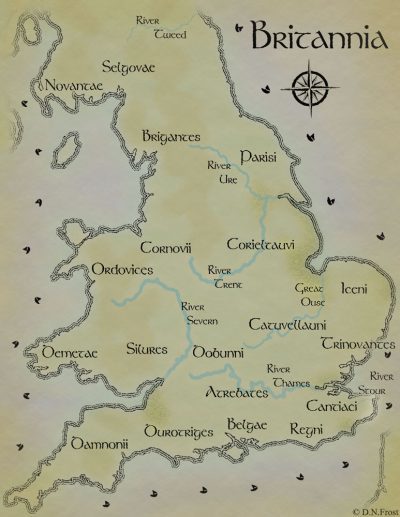
Map Ancient Britannia
The societies were dominated by the military and religious elite. The nobles considered themselves as part of wider Aristocracies that defined the larger ‘ethnic’ groups for their own ends. Rank and religion were more important in governing life. The inhabitants served empire-building rulers and royal dynasties that carved out fiefs.
Caesar’s most formidable foe in his invasions was Cassivellaunus. Caesar described him as a warlord and ‘robber-barron’ with no named people attached to him. His territory north of the Thames later coincides with the powerful tribe that became known as the Catuvellauni. It is interesting to note that most of the ‘named’ tribes Caesar mentioned in the 50s BC vanished a century later. This suggests instability and volatility of dynasties played a crucial role in triggering the Roman invasion by Claudius in 43 AD. The actions of some of these British rulers suggest their primary interests were personal power rather than the collective interest of their people.
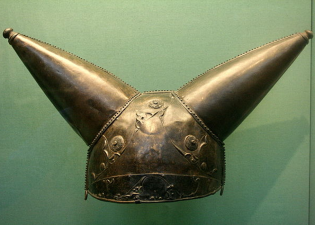
Celtic Horned Helmet Found at River Thames Date 150-50BC
British and Gallic Connection
Britannia was intimately interconnected to northern Gaul (modern-day France) well before Caesar’s time. Caesar writes that ‘within living memory’, Diviciacus, ruler of the Belgic Suessiones, exerted power on both sides of the English Channel. This suggests the importance of the dynastic links and the personal nature of power in Britannia. Caesar further reports that identical tribal names were found in both Gaul and Britannia, although he does not identify them.

Gold coins of the Sequani Gauls, 5-1st century BCE.
Archaeological findings from burial sites provide further evidence that a wealthy and privileged aristocracy arose prior to Caesar’s invasions. Cremation burial became fashionable in parts of southern Britannia. Luxury objects found in some of the tombs were more about feasting and drinking and less about war. The burial rites and grave-goods were Gallic imports or imitations. The richest graves are found near settlements such as Camulodunum (Colchester) that became more urbanized.

Linnea Tanner Beside Ancient Roman Wall in Colchester
Lowland Britannia was integrated into a wider political, economic, and cultural zone that spanned the British Channel and reached toward the Rhone Valley and the Alps. Some graves also contain war-jars and drinking vessels from Roman Italy, even before Caesar, a new symbol of power in southern Britannia.
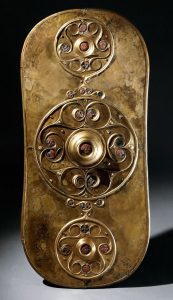
Celtic Shield Retrieved from Thames River
Caesar’s first two expeditions (55 – 54 BC) failed to bring the Britons under the direct rule of Rome that the Gauls were subjected. However, the southern territories in Britannia were exposed to a major foreign power across the channel that some British rulers used to help them in their internal political squabbles. British nobles found alliance with the Romans more appealing and in line with their personal interests.

Replica of Roman Dining Area at Fishbourne Roman Palace Built by Celtic King
Rome’s first emperor, Augustus, established administrative systems in Gaul. A network of roads and river transport stimulated trade between the channel coast and the Mediterranean. Roman-manufactured goods, ceramics, glass, wine, and oil now flowed through the Roman arteries of Gaul. Widespread trade was aided by a common currency, language, and bureaucracy which were unhindered by the old patchwork of Celtic tribal rivalries. The Thames estuary was the new gateway into Britannia and the tribes who controlled the entrance dominated access to Continental luxuries.
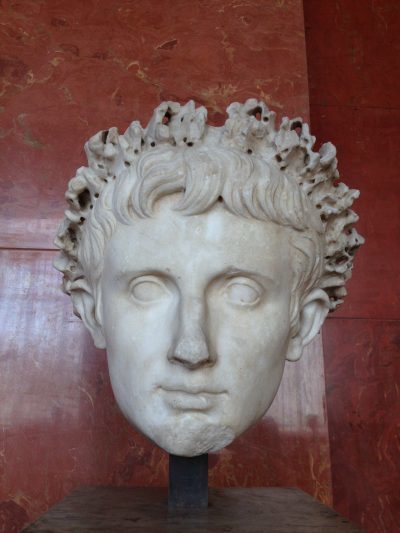
Augustus Caesar Statue Head
Augustus most likely maintained diplomatic links with Britannia to ensure the southeast stayed in the hands of friendly tribes. To the north were the ambitious and aggressive Catuvellauni (the name means ‘Men Good in Battle’). To keep them in their place, Rome cultivated their southern neighbors and rivals, the Atrebates. Commius’ sons (as they describe themselves on their coins) seem to have befriended Rome while mired in sibling rival. Tincomarus, the ‘Big Fish’ was ousted by Epillus in AD 7 and Epillus in turn by Verica in AD 15. Augustus was indifferent to their domestic squabbles, as long as the Atrebates stayed loyal to Rome and the balance of power was not disturbed. To the Romans, the rest of Britannia and Ireland beyond the trading gateway was remote and irrelevant.
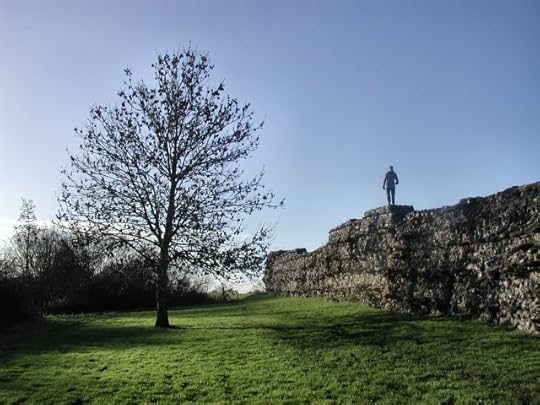
Roman Wall Calleva (Silchester)
At the time of Claudius’ invasion in 43AD, there was not a united national resistance, although some tribes fought fiercely. It is clear that many regimes in Britannia either welcomed the Romans openly or at least quickly came to terms. There was a striking difference between the rapid incorporation of lowland Britain into the Roman Empire and the far slower conquest of the highland regions.

Cupid Dolphin Mosaic Floor at Fishbourne Palace Built by Pro-Roman Celtic King
It took the Romans a generation to conquer what would be considered Wales and northern England while future Scotland and Ireland were never incorporated at all. Hadrian’s Wall built in 122 AD was an admission of failure.

Hadrian’s Wall in Northern England
Celtic Kings Southeast Britain
Coin evidence is no substitute for detailed political accounts; nevertheless. it provides us with the earliest names of the players in the 1st-century British power struggle. As a form of propaganda, the coins do not always tell the literal truth, but they provide a hint of tribal territories, alliances, and the political geography of southern Britannia in the decades before the Roman invasion in 43 BC.
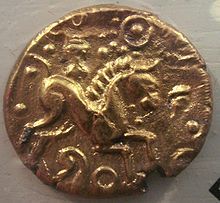
Celtic Gold Stater Minted by Tasciovanus, Catuvellauni
The Catuvellauni to the north of the Thames, and the Atrebates, to the south, became the dominant tribes at the time Augustus brought stability to Gaul beginning in 30 BC. Below is a map that provides the location of major Celtic tribes in Southeast Britain at the time of Rome’s Invasion of Britannia in 43 AD:
Atrebates, Belgae, Cantiaci, and Regni (South of Thames)
Trinovantes and Catuvellauni (North of Thames).
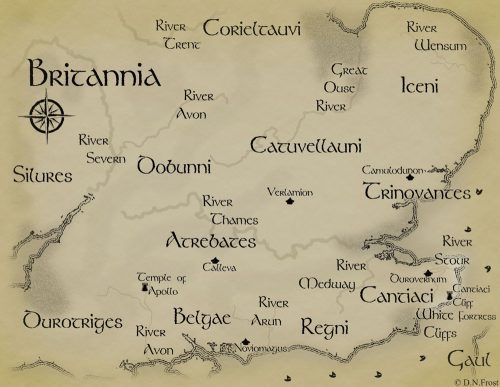
Map of Ancient Britannia 1st Century AD
The primary capitals of these Celtic tribal territories were Durovernum (Canterbury; Cantiaci), Camulodunum (Colchester; Catuvellauni & Trinovantes), Verulamion (St. Albans; Catuvellauni), Calleva (Silchester, Atrebates), and Noviomagus (Chichester; Regni)
After Caesar’s invasions, the most powerful British rulers began minting their own coins inscribed with their names. The pro-Romans rulers were permitted to inscribe the Roman title ‘Rex,’ meaning ‘king’ on the coins. Epillus, for example, issued coins with the inscription ‘rex calle[vae] – King of Calleva. Verica emblazoned a vine leaf on his, surely a reflection of his identification with the Mediterranean culture. Below is a list of rulers who were either recorded in Roman accounts or minted coins between Caesar’s and Claudius’ invasions.
Date
Rome
Southern Dynasty
Northern Dynasty
50 BC
Caesar’s Invasion
Mandubracius, Cassivellaunus
40 BC
Murder of Caesar
Commius
30 BC
Octavian & Antony Civil War
20 BC
Augustus Stabilization
Tincomarus
Addedomaros, Tasciovanus
10 BC
Eppillus
Cunobelin, Dubnovellaunos
1 AD
AD 10
Tiberius
Vodenos
AD 20
Epatticus
AD 30
Caligula
Verica
Adminius
AD40
Claudius
Caratacus, Togodumnus
To be continued
The next series of posts will describe the political struggles of pro- and anti-Roman rulers between Caesar’s expeditions in 55 – 54 BC and Claudius’ invasion in 43 AD.
References
David Miles, The Tribes of Britain, Phoenix, Imprint of Orion Books, Ltd., London, UK, 2006.
Graham Webster, Boudica: The British Revolt Against Rome AD 60, Reprinted 2004 by Routledge, London.
Simon James, The Atlantic Celts: Ancient People or Modern Invention; The University of Wisconsin Press, 1999.
Friedrich Neitzsche, Human, All Too Human, vol. I, p. 13; cited by Jung, Psychology and Religion, par. 89, n. 17.
©Copyright November 21, 2015, by Linnea Tanner. ALL RIGHTS RESERVED.
August 23, 2020
Cunobelin Celtic British King
The following is a reblog of a post entitled, “Cunobelin Celtic British King”, which was first published at this website on February 4, 2016. Cunobelin and his sons, Adminius and Caratacus, are actual historical figures on which characters in the historical fantasy series, Curse of Clansmen and Kings, are based. The article provides the historical backdrop on which the series is based.
________________________________________________
One thing that comes out in myths is that at the bottom of the abyss comes the voice of salvation. The black moment is the moment when the real message of transformation is going to come. At the darkest moment comes the light
—Joseph Campbell
Cunobelin Celtic British King
Cunobelin was considered the greatest of all of the Celtic British kings. The Romans referred to him as Britannorum Rex, the King of the Britons. He is also known as Cunobeline and Cunobelinus. He is the radiant character in Shakespeare’s Cymbeline and Geoffrey of Monmouth’s The History of the King of Britain written in 1136 AD. It is not clear where Cunobelin came from, but his rise to power was rapid and dramatic. He gained his throne in the early 1st century AD as a young man in his twenties or early thirties.

Statue of Dying Celtic Warrior
Overview of Celtic Kings in Southeast Britain
Below is an overview of Roman events and Celtic kings in Southeast Britain between Julius Caesar’s invasions in 54-55 BC and Claudius’ invasion in 43 AD.
Date
Roman Events
Southern Dynasty
Northern Dynasty
50 BC
Caesar’s Invasion
Mandubracius, Cassivellaunus
40 BC
Murder of Caesar
Commius
30 BC
Octavian & Mark Antony Civil War
20 BC
Augustus Stabilization
Tincomarus
Addedomaros, Tasciovanus
10 BC
Eppillus
Cunobelin, Dubnovellaunos
1 AD
AD 10
Tiberius comes to power
Vodenos
AD 20
Epatticus
AD 30
Caligula comes to power
Verica
Adminius
AD40
Claudius comes to power
Caratacus, Togodumnus
Cunobelin’s Rise to Power
Cunobelin claimed he was the son of Tasciovanus, the Catuvellauni ruler whose center of power was at Verulamium (present-day St. Albans). Upon his father’s death, Cunobelin gained power over the Catuvellauni. He then moved against the Trinovantes and extended his kingdom to the east. His father may have had an alliance between the two powerful tribes, possibly by dynastic marriage. It is also possible that he seized the throne in a palace revolt. He expanded his territory to the west and southward into Kent.
Cunobelin’s rise to power occurred at the same time that Roman Emperor Augustus had significant resistance in Germania that took higher precedence. In 9 AD, three Roman legions led General by Publius Quinctilius Varus were crushed by the Germanian Prince Arminius—a disaster of unparalleled magnitude. Augustus and his advisers were too preoccupied with the events to pay much attention to political upheavals in Britain. Cunobelin must have known he could act without any serious threat of Roman reprisals. An astute statesman, he gave assurance to Rome that the balance of power was not seriously affected. Roman traders were still welcome in Camulodunum (modern-day Colchester) and elsewhere north of River Thames.
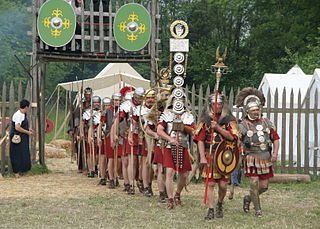
Roman Soldiers in Formation
Balancing Pro and Anti-Roman Factions
Geoffrey of Monmouth writes Cymbeline (i.e. Cunobelin) was a warlike man and insisted on the full rigor of the law. He was reared in the household of Emperor Augustus Caesar. Cunobelin was so friendly with the Romans that he might as well have kept back their tribute-money but paid it of his own free will. In the photograph of the Roma Ara Pacis Altar below, there is a little boy between Agrippa (Augustus’s son-in-law) and Livia (Augustus’s wife). The boy’s mother is shown in the background patting his head. Although this boy might be Agrippa’s son Lucius (born 17 BC) and the woman his mother Julia, he wears a tunic and Celtic neck-torc instead of a toga and is thus probably a barbarian prince. It is known that many children of foreign monarchs lived in the imperial court.

Celtic Child in Roma Ara Pacis Procession Hard Particolare
Cunobelin had to maintain a balance between two bitterly opposing factions for, and those against, Rome. In view of the expulsion of the pro-Roman rulers, Tincommius and Dubnovellaunos, around 8 AD, Cunobelin had to be careful throughout most of his reign not to show undue bias towards Rome. There were strong anti-Roman elements by Druids in the royal household. During his lifetime, Cunobelin successfully satisfied his own people, as well as persuading Rome of his loyalty while keeping the power of the Druids in check.
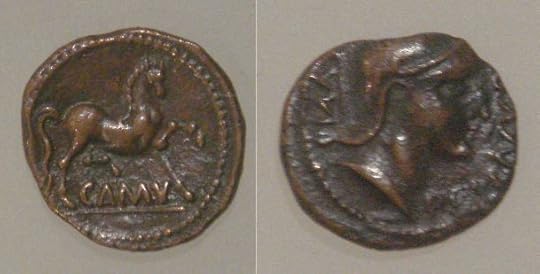
Bronze Coin with Image of Cunobelin
Camulodunum Oldest Recorded City
Cunobelin moved his capital to Camulodunum. It was considered the oldest recorded town in Britain, as it was mentioned by Pliny the Elder who died in 79 AD. The Celtic settlement was huge compared to hill forts to the west or north. Cunobelin minted his coins at this town to exploit trading with the Continent. The grave goods found in this area illustrate the impact of Rome on Camulodunum’s nobles in the early 1st Century. Items found included chain-mail armor, Roman bronze vessels, furniture, wine amphorae, and a medallion encasing a silver coin of Augustus, minted about 17 BC.
The nobles sustained their power and their lifestyles on the back of hard-working peasantry. Power was maintained by warriors whose loyalty had to be constantly rewarded. To maintain luxurious lifestyles, the Celtic rulers raided inland Britain for slaves. Neck chains used to restrain slaves have been found around Colchester and are on display at the museum in Colchester. Strabo notes that some British leaders procured the friendship of Augustus by sending embassies and paying tribute to him.
Cunobolin’s Expansion into Kent
Cunobelin expanded his influence into Kent, which became a fiefdom ruled under his son, Adminius. Durovernum (modern-day Canterbury). Like Verulamium and Camulodunum, the town functioned as a center for the elite, a gateway for Roman luxury goods, and a base for traders from the empire.
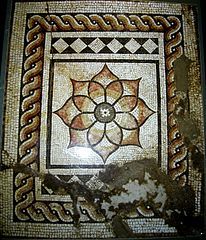
Mosaic Panel from Durovernum
Cunobelin had several sons of whom three, Togodumnus, Caratacus, and Adminius played significant roles triggering the Roman invasion in 43 AD. In Cunobelin’s final years, he had trouble over the succession. His sons shared administrative duties for various parts of his kingdom. In Cunobelin’s declining years, it is likely Rome became uneasy with the political uncertainties. It became increasingly clear that the valuable commercial asset in Britain needed to be secured either by renewing treaties with the new rulers or by military force.
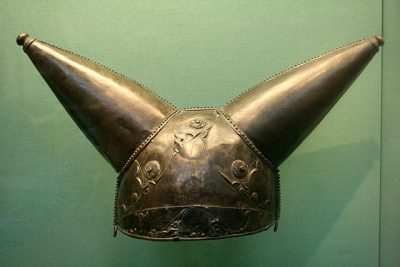
Celtic Horned Helmet Found at River Thames Date 150-50BC
Coinage minted by Adminius suggests that he ruled the Northeast part of Kent on behalf of his father a short time before his death. Adminius held pro-Roman sympathies whereas his brothers were anti-Roman. Emperor Caligula may have secretly collaborated with Adminius to set up a major seaborne operation to invade Britain. This could have been the reason that Cunobelin expelled Adminius from Britain in 40 AD. Suetonius records the banished prince with a group of his followers fled to a Roman encampment where Caligula was reviewing the troops in Germania. Caligula retained the Britons as hostages and dispatched a message to Rome proclaiming he had conquered the whole of Britain.
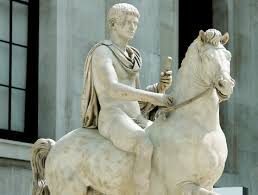
Caligula on a Horse
Subsequently, Roman troops appeared ready to invade Britain, but it is not clear what stopped the expedition. Possibly the troops rebelled and refused to embark the warships. Infamous for his bizarre behavior, Caligula paraded the troops in battle array on the shore and commanded them to collect seashells. Though the Roman invasion was abandoned, Caligula erected a great lighthouse at Boulogne. It stood as a memoir of this event until it was torn down in 1544 AD.
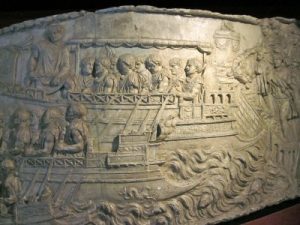
Frieze of Roman Warship
The precise date of the death of Cunobelin is not certain, but it must be within a year of 40 AD. This is when Caractacus conquered territories south of the Thames while Togodumnus inherited the kingdom. The flight of Adminius may be connected with these events.
Caratacus overthrew Verica, King of the Atrebates who also sought protection from the Romans. Verica appeared before Emperor Claudius claiming he had been driven out of Britain by an uprising. He called upon the Emperor to fulfill his obligation to reinstate him as a ruler under their treaty. Caratacus demanded that Claudius release Adminius and Verica to him—the final trigger that incited Claudius to invade Britain in 43 AD (see map below of ancient Britannia).

Map of Ancient Britan
References:
Geoffrey of Monmouth, “The History of the Kings of Britain.” Translated with an Introduction by Lewis Thorpe; First Published in 1966; Republished by Penguin Books, London England
David Miles, “The Tribes of Britain”, published in 2006 by Phoenix, an imprint of Orion Books, LTD, London.
Graham Webster, “Boudica: The British Revolt Against Rome AD 60, Reprinted 2004 by Routledge, London.
Graham Webster, “The Roman Invasion of Britain.” Reprinted in 1999 by Routledge, New York.
Joseph Campbell, “The Power of Myth with Bill Moyers.” Anchor Books, a Division of Bantam Doubleday Dell Publishing Group, New York, 1988.
©Copyright February 4, 2016, by Linnea Tanner. ALL RIGHTS RESERVED.
August 19, 2020
Amulet’s Rapture Audiobook Review and Interview
It is my pleasure to share my interview with Literary Titan about the audiobook of Amulet’s Rapture. The narrator is Kristin James (KJ The Voice Actor) who also narrated the first two audiobooks in this series: Book 1 Apollo’s Raven and Book 2 Dagger’s Destiny.
I’m also pleased to share Literary Titan’s review of the audiobook of Amulet’s Rapture for which they awarded a Gold Award. The award is based on the criteria that the audiobook is perfect in its delivery of original content, meticulous development of unique characters in an organic and striking setting, innovative plot that supports a fresh theme, and elegant prose that transforms words into a beautifully written book. The Gold Award is a tribute to Kristin’s skill as a voice actor covering a wide range of voices and accents.
Interview Literary Titan
Epic Historical Fantasy
JUL 19 Posted by Literary Titan
 Linnea Tanner Author Interview
Linnea Tanner Author InterviewI loved the narration in this audiobook. What was the collaboration like with narrator Kristin James to bring your book to life?
I’ve always had a great collaboration with Kristin James, the narrator of all of my audiobooks in the Curse of Clansmen and Kings series. Whenever we’re ready to do an audiobook, I send her a list of the most important characters along with their traits and background. For the new characters introduced in Amulet’s Rapture, Kristin provided me an audio example of the voice she would use for each of them. For the most part, her voice inflections of characters are spot on and I give her free rein on the dramatic interpretation of the book. She enjoys narrating some of the villainous or quirky characters such as Decimus (Catrin’s Roman master), Myrddin (Merlin-like Druid), Rhan (Sorceress), and Marrock (Catrin’s half-brother).
Were there any challenges or unique opportunities that were presented when creating your audiobook?
There are devoted fans of audiobooks that I might not reach with an e-book or printed book. It is always a thrill to hear Kristin’s narrative interpretation of my books. She brings the characters to life on the page. One of the biggest challenges of producing an audiobook for an epic historical fantasy is finding a narrator with a wide range of voices for the myriad of characters from different regions in the ancient world. Kristin has done a fantastic job creating distinctive voices, both male and female. For characters from Britannia who only speak Celtic, Kristin narrates their dialogue with a Gaelic accent. The Roman characters have various British accents while the other Celtic characters who can speak Latin have a US accent. One of the new characters in Amulet’s Rapture is Negasi, an Ethiopian gladiator who befriends Catrin and speaks with an African accent.
What is one scene from the audiobook that stands out to you as different from the way it’s presented in the book?
This is a hard question to answer. There were several scenes that Kristin brings to life with her narration. One of the scenes that gives hints on how the series will unfold is provided in Chapter 8 entitled, “Rhan’s Baby.” This is a surrealistic scene in which Rhan—a sorceress who cast a curse that Catrin’s father would be slain and overthrown by his son, Marrock— levitates between life and death after giving birth to her daughter. Rhan envisions her curse, which has been etched on a dagger blade, melting and transforming into another curse, foretelling Marrock will meet the safe fate as his father at the hands of Catrin. Kristin captures the dreamlike scene as though it is actually happening to Rhan. There are other similar scenes in which fantasy and reality weave together to drive the story
For the original post, click on Epic Historical Fantasy
Literary Titan Review
Amulet’s Rapture
JUN 28Posted by Literary Titan

Catrin is living a nightmare. She has become a slave, is used and abused as a woman disguised as a soldier, and the love of her life doesn’t remember the passion that once existed between them. Catrin is as feared as much as she is taken for granted. Considered to have powers that far outshine the abilities and skills of any soldier, she is allowed to live and protected even though she isn’t respected. Marcellus, her love, now under the spell of another, can’t quite shake the feeling that something is not right–something he can’t explain but leaves him feeling empty and broken. Catrin knows, but will she be able to tell him in time?
Amulet’s Rapture, by Linnea Turner, continues the journey of young Catrin. Her life, very different from that of previous installments, is a daily struggle for survival. She is only allowed to live because she is deemed valuable and believed to have the ability to speak directly with the sun god. Catrin is put through ghastly tasks and treated with little respect even though she is offered the opportunity to train as a warrior priestess. Playing along with the idea that she is all-powerful is the only thing that seems to keep her from being killed.
Catrin’s visions are an important part of the plot–the thread woven discreetly throughout the story that ties all of the elements neatly together. The images she conjures are vivid and touching. The author uses them expertly to pull in elements from previous installments. These little trips into Catrin’s past are especially helpful if listening to this as a stand alone.
The audio version of Amulet’s Rapture is a fascinating listen. The narrator absolutely nails tone, character changes, and emphasis. In addition, the particularly intense scenes in which Catrin is being threatened are completely captivating when read by the narrator, Kristin James. What would be moving moments if read in paperback or Kindle become quite terrifying and extremely uncomfortable when listening to the narrator’s interpretation of the text–the story is truly brought to life.
I believe this installment is completely readable as a stand-alone text. The author provides quite a bit of background, and Catrin’s visions give readers a nice glance back at previous plots. One cannot read Tanner’s work without calling it romance. Though it is primarily a fantasy, readers who seek a strong romantic feel to their fantasies will appreciate Tanner’s writing. She peppers her plot with just enough of these steamy scenes to keep romance fans invested.
Audio Length: 11 hours and 11 minutes | ASIN: B0887Y9WLY
For the original post, click on Amulet’s Rapture
The audiobook of Amulet’s Rapture can be downloaded from at the following sites:
Order from Amazon
Order from iTunes
Order from Google Play
Hope everyone keeps safe and healthy during these difficult times. Thank you for your continued support.
Best wishes,
Linnea Tanner

August 10, 2020
#RRBC Writers’ Conference and Book Expo #WCBE20
CHECK OUT RRBC’s 5th Annual WRITERS’ CONFERENCE & BOOK EXPO
(WC&BE) now open virtually to the public!
RAVE REVIEWS BOOK CLUB (RRBC) provides support for authors and aspiring writers. RRBC challenges it’s author members to strive to learn more, grow more, and be better than they were the day before. In previous years, the RRBC conferences opened up windows of opportunities for their members to meet and mingle with fellow members they had never met before. Many of them become close colleagues and friends down through the years.
I’m an RRBC author-member and will be participating in this year’s event.
THIS YEAR’S EVENT HELP AUTHORS…
*Get inspired to write more, and more creatively
*Successfully market your work to actual readers
*Strengthen your writing skills, and even allow you to…
*Network with like-minded individuals who can aid you on your writing journey.
Check out some of the amazing and diverse authors at the Author Booths for RRBC members to showcase, promote, and sell their books, and also Vendor Booths offering amazing services. If you’ve attended RRBC conferences in the past, you will notice that this year, each author booth will house even more personal flair and design than last year. No two booths will be alike, so I hope you’ll enjoy the extra-special touches!
No event is ever complete without giveaways. RAFFLE this year is back and made fully possible by (member) SPONSORS! As always, RRBC will be raffling gift card/gift baskets, and there will also be door prizes up for grabs in every Author & Vendor Booth; all you’ll have to do to win door prizes is ensure that you’re leaving comments in every booth!
All of this education, fellowship, and fun is right here in ONE place … and the best part is, you get to enjoy it all from the comfort of your very own home, or wherever you have an internet connection!
This event will run for one full week, August 10 through August 16 … with a few additional dates tacked on.
WC&BE has been going strong since 2016 and it is always our most highly anticipated club event each year. Even with all that’s going on in the world right now, this year’s event allows us the outlet to feel as if life is continuing on and that the pandemic of 2020 has not stripped us of everything we love.
Hope you check out #WCBE20 for more information about the event and RRBC.
Best wishes,
Linnea Tanner

July 27, 2020
Book Review: Break of Darkness by Ryanne Glenn
Below is my Goodread book review of Break of Darkness by Ryanne Glenn and her biography and contact information.
 Break of Darkness by Ryanne Glenn
Break of Darkness by Ryanne Glenn
My rating: 5 of 5 stars
Break of Darkness by Ryanne Glenn is the final, most compelling book in the Descent of Shadows epic fantasy series that has followed the journey of Anna, a young general battling shadowy creatures known as wraiths. In the third book, survivors from the sanctuary city that King Ramiere destroyed are in the depths of despair. Disheartened by the devastation, Anna escapes to a foreign land, hoping to erase her memories of the ravages of relentless war with the wraiths. Her regiment is in disarray and struggling to survive the continuing wraith onslaught. Anna seeks insight from her ancestral past to help her overcome the dark magic of King Ramiere. However, the light Anna finds also has shades of darkness that she must embrace to defeat him before he destroys the human race. Not only is the tale about battles between sworn enemies, but it is also about Anna’s inner struggle to accept herself and to unify her troops to do the impossible—overcome King Ramiere.
The final book has a heart-wrenching but satisfying ending to the series. Author Ryanne Glenn has masterfully written an epic journey of a young woman struggling to find herself and to regain loyalty from her soldiers who believe she had abandoned them. It is a multi-layered tale that explores human frailties and friendships which can forge during times of despair. The three-dimensional characters are engaging, particularly the eighteen-year-old heroine, Anna, who must come to terms with her darker side. King Ramiere is a complex villain with a diabolical plan to destroy humans so he can save his wraiths from the destructive forces of light. The book is rich in detail, setting the mood, and has a heart-throbbing climax that will keep you on the edge of your seat.
I highly recommend the series to both teens and adults. Break of Darkness realistically depicts the consequences of war on the souls of individuals, but it is also a morality tale of how friendship is the ultimate victor in times of despair.
About Ryanne Glenn

Ryanne Glenn is a member of the Northern Colorado Writers in Fort Collins, CO, where she attends Colorado State University. She is pursuing a degree in Chemical and Biological Engineering with a minor in Biomedical Engineering. She loves to golf, though after playing for twelve years, her handicap should be much lower than it is. Between writing and classes, she often visits her hometown of Fruita, Colorado, to spend time with her family and two dogs, Coco and Pebbles.
Ryanne started writing short stories when she was ten and was first published in Fruita’s local newspaper. She took her first creative writing class in high school and was inspired to expand her writing into poetry and longer stories. After struggling with depression in her first year at college, she turned back to writing as a healthy outlet for her emotions. She wants to write strong female role models and is excited to share her stories with the world.
You can purchase Break of Darkness by clicking on the following:
Amazon
Barnes and Noble
Atthis Arts, LLC
You can contact Ryanne Glenn by clicking on the following:
Website
Facebook
Twitter
BookBub
July 23, 2020
AUTHORSXP FANTASY BOOKS GIVEAWAY
For a chance to win fantasy paperbacks and e-books, enter the AuthorsXP Fantasy Books Giveaway. I am a participating author in this event and will be giving away books in the Curse of Clansmen and Kings series: Book 1 APOLLO’S RAVEN, Book 2 DAGGER’S DESTINY, and Book 3 AMULET’S RAPTURE.
CLICK below for a chance to be a big winner!
Win up to 20+ Fantasy eBooks!
(2) Grand Prize “Gift Baskets” of ALL eBooks!
(20+) Winners of Individual eBooks (randomly selected titles)
Thank you for your continued support!
Best,
Linnea Tanner

July 8, 2020
Welcome to Day 4 of #RRBC’s July “SPOTLIGHT” Author Tour for Karen Black! @KarensStories
It is my pleasure to welcome you to Day 4 of RRBC’s July “SPOTLIGHT” Author Tour for Karen Black, a member of Rave Reviews Book Club. Below, you’ll learn about what inspired Karen Black to write and discover some of the work she has published. I hope you’ll support her at every stop of her blog tour!

Meet Karen Black
As soon as I learned to read, I became a voracious book lover. After I mastered “Dick and Jane,” Nancy Drew became my heroine, and Agatha Christie’s incredible Hercule Poirot fascinated me. Dick Francis was a favorite author of mine, too, probably because his novels took place at the racetrack. The Dick Francis novels fed my appetite for two loves: horses and mysteries.
In the old days, clouds had magical qualities. A favorite pastime was to watch them and find an image and create a scenario around it. Although I didn’t realize it then, cloud watching was my introduction to flash fiction. My childhood fascinations stayed with me and they are apparent in the stories that I write.
“Long Stories Short” is a collection of ten short stories. I tried to create scenarios that are believable, or at least within the realm of possibility. There are, of course, exceptions. For example, “Magic or Miracles” is a story with paranormal overtones that might be possible. But someone who doesn’t believe in what they can’t see might find “Indisputable Evidence” difficult to believe.
“LONG STORIES SHORT”

“Race into Murder” is my first novel, and it came as no surprise to those who know me, that it is a mystery set at a thoroughbred racetrack.
“RACE INTO MURDER”

My most recent eBook, “Treacherous Love,” is a short story about misdirected passion that often occurs in situations of domestic abuse. It is the first of several stories that will be included in my next anthology.
“TREACHEROUS LOVE: A SHORT STORY OF MISDIRECTED PASSION”

About Karen Black
Karen Black lives in the eastern United States, with her husband and a variety of critters, wild and domestic. Hobbies include herb gardening, wildlife watching and winemaking, though all are put on hold when she’s caught up in a story. With a lifelong affection for animals, a fascination with the supernatural and a background in criminal justice, the author draws on experience, as well as imagination to create stories that are believable, unique, and entertaining. Expect the unexpected.
Contact Karen Black at:
Twitter: @KarensStories – https://twitter.com/KarensStories
Facebook: Stories by Karen – https://www.facebook.com/StoriesbyKaren/
Website: Stories by Karen – https://storiesbykaren.org/
To follow along with the rest of her tour, please visit the “SPOTLIGHT” Author forum on the RRBC site!
***
If you’re an author and interested in receiving this kind of support for you and your work, please join us at RAVE REVIEWS BOOK CLUB! We look forward to adding your name to our roster and your books to our catalog!
July 5, 2020
Book Review Owen by Tony Riches
 Owen by Tony Riches
Owen by Tony Riches
My rating: 5 of 5 stars
The legacy of King Henry VIII has always fascinated me, but I knew very little about the earlier accounts of the Tudor dynasty. Thus, I selected Owen: Book One of the Tudor Trilogy by Tony Riches to learn more about how the Tudor Dynasty was established. The story of Owen, the great-grandfather of Henry VIII, is as fascinating as the tales about the legendary king. Told in the first-person perspective of Owen, the story begins in 1422 when he first meets his new mistress, Queen Catherine of Valois, the young widow of King Henry V. The queen’s young son, Harry (Henry VI), is crowned King of England and France. Nobles responsible for the young king’s upbringing tightly control the queen’s life and her influence on her son. Owen, serving as the Keeper of the Wardrobe, loyally serves and befriends Queen Catherine and gains her trust. Rumors of Catherine’s affair with the 2nd Duke of Somerset prompts a parliamentary statute that forbids her to remarry until her son comes of age. Soon after, Catherine and Owen fall in love and secretly marry in the backdrop of political turmoil that ultimately leads to the War of Roses.
Author Tony Riches has masterfully written a poignant love story narrated by Owen in the present tense. The moment-by-moment narrative helps the reader more actively engage with Owen’s life journey. The story is rich with vivid descriptions and natural dialogue that highlights Owen’s wit and cleverness. Although his childhood has been shattered by the loss of his Welsh noble parents and heritage, Owen becomes the unlikely second husband to Queen Catherine and the father of her children. Their secret love and marriage have tragic consequences in the backdrop of the War of Roses. Yet Owen’s firstborn son, Edmund, ultimately becomes the father of King Henry VII, the first monarch in the Tudor Dynasty.
Owen: Book One of the Tudor Trilogy is one of the best historical fiction novels I’ve read this year. I highly recommend this book to historical fiction readers, particularly those interested in the Tudor Dynasty.

